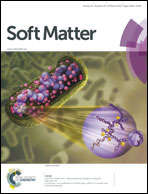Liquid marbles prepared from pH-responsive self-assembled micelles†
Abstract
In this study, we report the assembly of amphiphilic polymeric micelles at the liquid/air interface to prepare liquid marbles for the first time. The polymeric micelles were synthesized from the self-assembly of a fluoropolymer, poly(styrene-co-acrylic acid-co-2,2,3,4,4,4-hexafluorobutyl methacrylate), in a selective solvent. The particle size, morphology and chemical composition of the micelles were determined by dynamic light scattering (DLS), transmission electron microscopy, scanning electron microscopy and X-ray photoelectron spectroscopy. DLS and aqueous electrophoresis revealed the pH-responsiveness of the micelles in aqueous dispersion. Liquid marbles with water volumes varying from 10 μL to 1 mL were formed by rolling water droplets on the micelle powder bed. The increase in water volume led to the shape transition of the liquid marbles from quasi-spherical to a puddle-like shape because of gravity. Fluorescence microscopy was used to observe the morphology of the formed liquid marbles, which confirmed that the micelles were adsorbed at the interface of water and air. The effective surface tension of the liquid marbles decreased with the increasing concentration of NaOH, which was added to the interior water phase. This agreed with the results of droplet roller experiments: the mechanical integrity of the liquid marbles prepared from alkaline solution (pH 10) was relatively poorer than those prepared from acidic solution (pH 2). Moreover, these liquid marbles coated with micelles showed pH-responsiveness when transferred onto the surfaces of aqueous solutions with different pH values. The liquid marbles were relatively stable on the acidic solution, whereas they burst immediately on the alkaline solution with a pH of 10. In addition, apart from water, Gellan gum solution and glycerol could be also successfully encapsulated by the fluorinated micelles to form stable liquid marbles.


 Please wait while we load your content...
Please wait while we load your content...